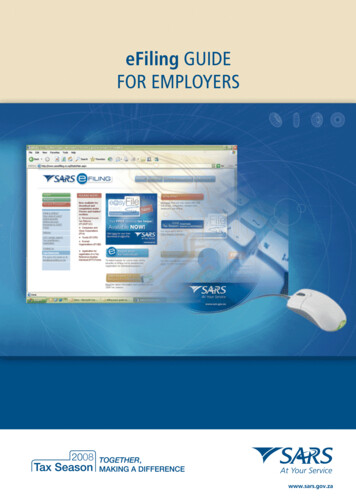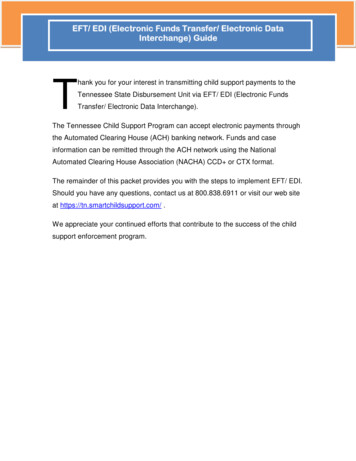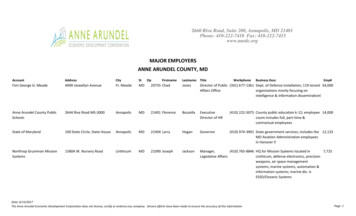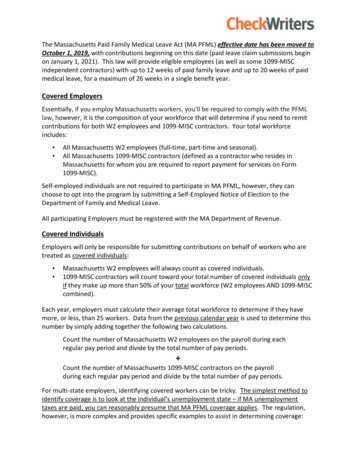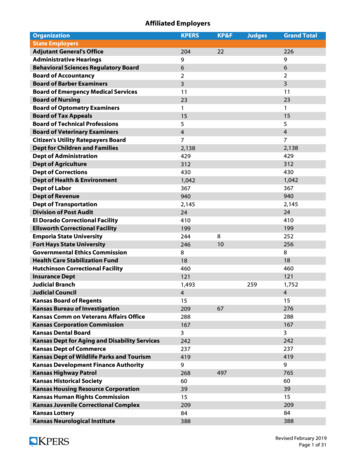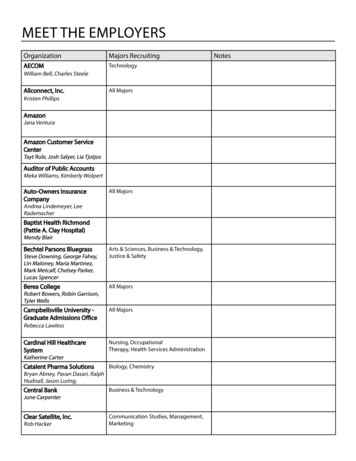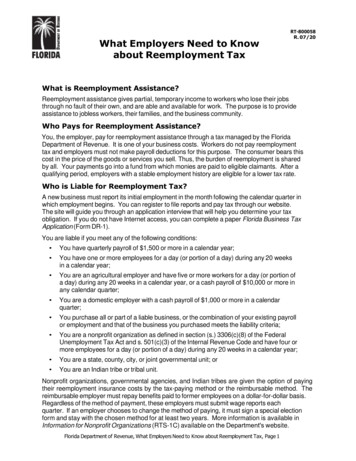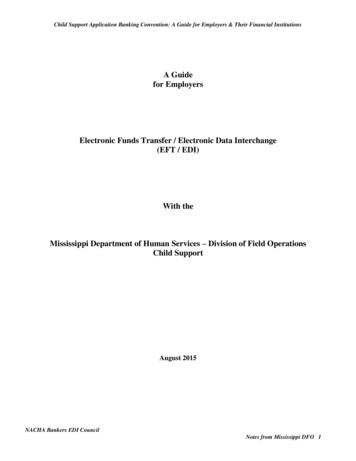
Transcription
Child Support Application Banking Convention: A Guide for Employers & Their Financial InstitutionsA Guidefor EmployersElectronic Funds Transfer / Electronic Data Interchange(EFT / EDI)With theMississippi Department of Human Services – Division of Field OperationsChild SupportAugust 2015NACHA Bankers EDI CouncilNotes from Mississippi DFO 1
Child Support Application Banking Convention: A Guide for Employers & Their Financial InstitutionsThe following information was taken from the Child Support Banking Convention: Guide for Employers and TheirFinancial Institutions, which was published by the National Automated Clearing House Association (NACHA)Bankers EDI Council, with information specific to the state of Mississippi incorporated. The Bankers EDI Council hasalso published another excellent document specifically for states, Child Support Application Banking Convention: AGuide for CSE Entities and Their Financial Institutions. Complete copies of these documents may be purchased bycontacting NACHA at: Telephone: (703) 742-9190Fax: (703) 787-0996Email: bedic@nacha.orgWeb site: www.nacha.orgAdditional copies of the employer packets may be obtained by contacting 769-777-6111.I.PurposeThe purpose of this information is to provide employers and their financial institutions with an overview of procedures,current formats, definitions and implementation recommendations to electronically remit child support payments andpayment information through the Automated Clearing House (ACH) Network according to the conventions andstandards supported by the banking and child support communities. Where needed, information specific to the State ofMississippi has been incorporated.The convention forms the basis for remitting child support withholdings together with remittance detail about thepayments using the National Automated Clearing House Association (NACHA) CCD format. Remittance detail for asingle payment is conveyed in the 80 character Payment Related Information field of the single Addenda Record of theCCD .Some states also allow employers to electronically remit these payments using the NACHA CTX format containing anAccredited Standards Committee (ASC) X12 820 Payment Order/Remittance Advice Transaction Set. Use of theCTX/820 enables an employer to combine multiple child support payments with remittance information in onetransaction to a single receiving entity. With a maximum allowance of 9, 999 Addenda Records, the CTX formatallows the entire 820 transaction set to be “enveloped” within the ACH format.A banking convention typically refers to standard format for the presentation of data within a single Addenda Record.When that convention is incorporated into the X12 standards, it is referred to as a data segment. The followinginformation depicts the status of the DED data segment of the ASC X12 820 as of version release 3050, published inDecember 1994 by the Data Interchange Standards Association (DISA). Mississippi allows employers to remit thesepayments using CCD or CTX formats.III.ProcessAn employer is notified to withhold wages of a particular employee by an income withholding order, generated eitherfrom a court, or a state, or local child support agency. The order instructs the employer to withhold wages from one ofits employees and serves as the employer’s legal basis for doing so. The order either provides the MississippiDepartment of Human Services – Division of Field Operations/Child Support (MDHS-DFO) case number, and theappropriate address for remitting payments and payment-related information or directs the employer where to call toobtain the necessary information.The employer should contact its financial institution to determine the institution’s EDI and EFT capabilities, and toseek assistance with formats, standards and technical requirements to implement this application. The employershould also determine the software required to implement this application. Note: MDHS-DFO does not providesoftware. The employer should contact their financial institution to determine whether software should be purchasedNACHA Bankers EDI CouncilNotes from Mississippi DFO 2
Child Support Application Banking Convention: A Guide for Employers & Their Financial Institutionsor developed.The employer should provide MDHS-State Disbursement Unit (SDU) with a verification list/file of their currentemployees. MDHS-SDU will compare the list to our current files and notify the employer of any differences (e.g.employee names, case numbers, SSN verifications, service location, billing address, FEIN, etc.), if necessary. Contact769-777-6111 for any questions regarding verification lists/files.Note: All verification lists/files must be reviewed by MDHS-SDU staff prior to transmittal of a pre-note/test fileor a complete file. Pre-note/test file is discussed below.In order to transfer the funds and data, the employer transmits the payment instructions and remittance information toits financial institution. The financial institution then originates the ACH entries to transfer the payments andremittance information through the ACH Network to MDHS-SDU’s financial institution (e.g., court, state or localagency) to which the payments must be sent. This process should initially be completed using a pre-note/test file. Thepre-note/test file allows all technical staff (the employer, the financial institutions, and MDHS-SDU the opportunity toidentify any possible errors, which should be corrected prior to transmittal of an entire file.Once received, MDHS-SDU’s financial institution posts the funds to the account and provides the remittanceinformation associated with those payments in the agreed format. Please contact 769-777-6111 for additionalinformation concerning technical assistance, formats, and standards regarding any electronic remittances.MDHS-SDU will update its records and disburses the payment by issuing a check to the custodial parent. Directdeposit of child support payments is not available in Mississippi at this time.IV.NACHA Record FormatsThe rules and guidelines governing the formats, specifications and exchange of ACH entries are published byNACHA. With respect to the data that is contained in the Addenda Records of ACH formats, the NACHA OperatingRules stipulate the type of data that may be exchanged as well as which standards and formats are permitted, but thestructure of the data contents is managed outside of the NACHA rules.For example, the NACHA Operating Rules permit the exchange of NACHA-endorsed banking conventions within theAddenda Record of the CCD format, but groups such as the Bankers EDI Council develop and maintain bankingconventions. Also, the rules permit the exchange of certain EDI messages or transaction sets (e.g., 820 PaymentOrder/Remittance Advice) within the Addenda Records of the CTX format, and X12 syntax-based data segmentswithin the Addenda Records of the CCD and the PPD formats, but those standards are developed and maintained byother standards development organizations, such as ASC X12 and UN/EDIFACT.The following record formats are used to convey entries through the ACH Network: File Header RecorderCompany/Batch Header RecordEntry Detail RecordAddenda RecordCompany/Batch Control RecordFile Control RecordAn ACH file is bounded by one File Header Record and one File Control Record, which serve to facilitatetransmission, identification and balancing of the file. A file may be comprised of one or more batches, which aredenoted by the Company/Batch Header Record and Company/Batch Control Record. These records containinformation specific to all of the Entry Detail Records contained within that batch. A batch may house one or moreEntry Detail Records that share certain aspects as explained in the NACHA Operating Rules. The Entry Detail Recordis the record that constitutes the payment order and is used within the banking system to execute EFT and settlement.NACHA Bankers EDI CouncilNotes from Mississippi DFO 3
Child Support Application Banking Convention: A Guide for Employers & Their Financial InstitutionsAn Addenda Record is used to supply additional payment related information related to the payment issued in theEntry Detail Record. Each Addenda Record includes an 80 position Payment Related Information Field within whichthis remittance detail is transmitted.The CCD and CTX payment formats are used within the ACH Network to conduct the transfer of funds betweenbusiness or government entities. To exchange data along with payments using EDI technology, Addenda Records areused. Under the NACHA Operating Rules, a CCD format may be accompanied by only one Addenda Record, whichmay carry X12 data segments or elements or NACHA-endorsed banking conventions. A CCD entry accompanied byan Addenda Record is referred to as a CCD . The CTX format allows for the provision of 9,999 Addenda Records,which may be used to carry certain X12 transaction sets or UN/EDIFACT message in their entirety.The NACHA record formats for CCD entries flow in the following order:File Header RecordCompany/Batch Header RecordEntry Detail RecordAddenda Record (1 addenda with 80 byte Payment Related Information FieldEntry Detail RecordAddenda Record (1 addenda with 80 byte Payment Related Information Field)Entry Detail RecordAddenda Record (1 addenda with 80 byte Payment Related Information Field)Entry Detail RecordAddenda Record (1 addenda with 80 byte Payment Related Information Field)Company/Batch Control RecordFile Control RecordLayouts for the NACHA Entry Detail and Addenda Records used with the CCD and CTX formats are shown on thefollowing page. To obtain a full citation of the rules, specifications and formats for the ACH Network, refer to theNACHA Operating Rules.NACHA Bankers EDI CouncilNotes from Mississippi DFO 4
Child Support Application Banking Convention: A Guide for Employers & Their Financial InstitutionsNACHA Bankers EDI CouncilNotes from Mississippi DFO 5
Child Support Application Banking Convention: A Guide for Employers & Their Financial InstitutionsV.Child Support Application Banking ConventionWithin the 80 position Payment Related Information File of the CCD Addenda Record, remittance informationcorresponding to the child support payment originated from one CSE agency to another is presented in the followingbanking convention. This convention is referred to as the ‘DED’ Deduction data segment under ASC X12 syntax andis composed of ten fields: Segment IdentifierApplication IdentifierCase IdentifierPay DatePayment AmountNon-Custodial Parent Social Security NumberMedical Support IndicatorNon-Custodial Parent NameFIPS CodeEmployment Termination IndicatorEach of these fields is referred to as a data element, which is the smallest named item in a record. It can represent aqualifier, a value, or text. A data element has three primary attributes - length, field requirement, and type. Each dataelement is identified by an element identifier used for reference (e.g., DED01, DED02, etc.) and each data element hasa specific position within the record (segment). In constructing the segment, each data element (except for the first) ispreceded by the separator character. In the ACH Network, the data element separator is an asterisk (‘*’). Eachsegment must end with a terminator, which in the ACH Network is a backslash (‘\’).The following is an example of the DED segment as used in the Payment Related Information field of the AddendaRecord:DED*application identifier*case identifier*pay date*payment amount*non-custodial parent ssn* medical supportindicator*non-custodial name*FIPS code*employment termination indicator\Note the use of the asterisk (‘*’) and backslash (‘\’).Data elements in a segment are either mandatory or optional. Data elements in a segment that are not mandatory asdefined by the standard may be omitted. The omission of an optional element is noted by the placement of an asteriskin the place of that element. For example, in non-custodial parent name were to be omitted from the segment, it wouldlook like this:DED*application identifier*case identifier*pay date*payment amount*non-custodial parent ssn*medical supportindicator**FIPS code*employment termination indicator\Also, if an optional data element is the last data element in a segment, and that field is not being used, the precedingasterisk is replaced by the backslash. For example, if the employment termination indicator is omitted from thesegment, it would look like this:DED*application identifier*case identifier*pay date*payment amount*non-custodial parent ssn*medical supportindicator*non-custodial parent name*FIPS code\The following grid delineates the format for the DED Segment (Convention) for interstate payments:DED Child Support Segment/Convention for EmployersNACHA Bankers EDI CouncilNotes from Mississippi DFO 6
Child Support Application Banking Convention: A Guide for Employers & Their Financial ment IdentifierDEDMID3/3DED01Application IdentifierXXMID2/2DED02Case IdentifierXXXXXXXXXMAN1/20DED03Pay DateYYMMDDMDT6/6DED04Payment Amount CCMN21/10DED05Non-Custodial Parent Social Security NumberXXXXXXXXXMAN9/9DED06Medical Support Indicator‘Y’ - Yes, ‘N’ - NoMAN1/1DED07Non-Custodial Parent NameXXXXXXXXXXOAN1/10DED08FIPS CodeXXXXXXXOAN5/7DED09Employment Termination Indicator‘Y’ - YesOAN1/1Sample DED ,HARR*A4738*Y\(Reminder: due to the one-addenda limitation of the CCD format, the DED segment is restricted to a maximum of 80characters. Note the use of the asterisk and backslash.)The column headings used on the grid are as follows: Element defines the data element nameComments and Content define the data elementAttributes are defined as follows:1.Field Requirement - The first column of the attributes is the field requirement for that data element. An ‘M’denotes a mandatory element, whereas an ‘O’ denotes an optional element.2.Date Type - The second column of the attributes specifies the field data type.‘AN’ denotes a string type data element. Contents of string data elements are a sequence of letters, digits,spaces and/or special characters (with the exception of the asterisk and backslash). The contents must be leftjustified. Trailing spaces should be suppressed unless they are necessary to satisfy a minimum lengthrequirement.‘DT’ denotes a data type data element. Format for the date is YYMMDD. YY is the last two digits of theyear (00-99), MM is the numeric value fro the month (1-12), and DD is the numeric value of the day (1-31).‘ID’ denotes an identifier data element from a pre-defined list of values.‘N2’ denotes a numeric type data element with two decimal places to the right of a fixed, implied decimalpoint. The decimal point is not transmitted. It is intended that this number will always be positive for thechild support application banking convention. Thus the amount, 135.47 would appear as *13547*.NACHA Bankers EDI CouncilNotes from Mississippi DFO 7
Child Support Application Banking Convention: A Guide for Employers & Their Financial Institutions3.Length - The third column of the attributes signifies the minimum/maximum use of an element. This specifiesthe minimum and maximum length of a particular field. For example, 1/6 indicates that this date element mustbe at least one character, but not more than six.Element DefinitionsDED01ApplicationIdentifier:Supported Code Value - ‘CS’ - Child SupportThe application identifier indicates the type of deduction being withheld from an employee’s pay.DED02 Case Identifier:The case identifier element is the IV-D case number or court order number. The case identifier always refers to theidentification number of the case in the state receiving the EFT/EDI transaction (e.g., the child support receivingagency). This is true whether the transaction is from an employer or another state. The child support receiving agencydetermines which number to use.DED03 Pay Date:The pay date provides the obligor’s (non-custodial parent) pay date or the date of the income withholding (i.e., the datethe funds were withheld by the employer).DED04 Payment Amount:The payment amount element indicates the non-custodial parent’s withholding amount for this pay period being paid tothe child support receiving agency.DED05 Non-Custodial Parent Social Security Number:The non-custodial parent Social Security Number element provides the SDU agency receiving the transaction with thenon-custodial parent’s Social Security Number.DED06MedicalSupportIndicator:Supported Code Values - ‘Y’, ‘N’The medical support indicator indicates whether the non-custodial parent has family medical insurance coverageavailable through his/her employer. If medical insurance coverage is available through his/her employer, a ‘Y’ is used;if there is no coverage available, an ‘N’ is used.DED07 Non-Custodial Parent Name:The non-custodial parent name element indicates the first seven letters of the non-custodial parent’s last name followedby the first three letters of his/her first name. A comma must be used to separate the last name from the first name ofthe custodial parent when the last name is less than seven characters.DED08 FIPS Code:The Federal Information Process Standard (FIPS) code refers to the FIPS Code of the child support entity receiving thetransaction. It is five characters when indicating both the state and county codes. It is seven characters whenindicating state, county, and local codes.DED09Employment Termination Indicator:NACHA Bankers EDI CouncilNotes from Mississippi DFO 8
Child Support Application Banking Convention: A Guide for Employers & Their Financial InstitutionsSupported Code Value - ‘Y’The employment termination indicator is used to notify the child support agency that an individual’s employment hasterminated. A ‘Y’ is placed in this field if the employee has been terminated otherwise, the field is not used. Thepayment amount field may contain zero when this field is used.VI.CTX Format & ASC X12 820 Payment/Order Remittance AdviceAt a minimum, state child support entities were required to accept employer originated child support withholdingpayments sent in the NACHA CCD format by October 1, 1997, and therefore many states already have this capability.An increasing number of states are capable of sending and receiving these payments made using the CTX formatcontaining the ASC X12 820 transaction set. As indicated previously, the CTX format may have up to 9,999 AddendaRecords associated with each Entry Detail Record, thus greatly expanding the reporting potential. Going forward, thenumber of child support entities supporting the CTX/820 option will rise; therefore, a state should check with the childsupport entity receiving the payment to determine if it can receive and process the CTX/820. The employer shouldcontact its financial institution to verify input options as well as the institution’s ability to originate a CTX format.The Addenda Record of the CTX format containing the ASC X12 820 transaction set used to send child supportpayments would typically be comprised of the following data segments:ISAInterchange Control Header:(mandatory)A control segment used to start and identify an interchange of zero or more functional groups and interchange-relatedcontrol l segment used to indicate the beginning of a functional group and to provide control rol segment used to indicate the start of a transaction set and to assign a control number (e.g., ST*820selects the 820 transaction Advice:(mandatory)Segment used to indicate the beginning of a Payment Order/Remittance Advice Transaction set and total paymentamount or to enable related transfer of funds and/or information from payer to payee to occur. This segment identifiesthe dollar value of the payment along w
Child Support Application Banking Convention: A Guide for Employers & Their Financial Institutions NACHA Bankers EDI Council Notes from Mississippi DFO 1 A Guide for Employers Electronic Funds Transfer / Electronic Data Interchange (EFT / EDI) With the Mississippi Department of Human Services – Division of Field Operations Child Support

